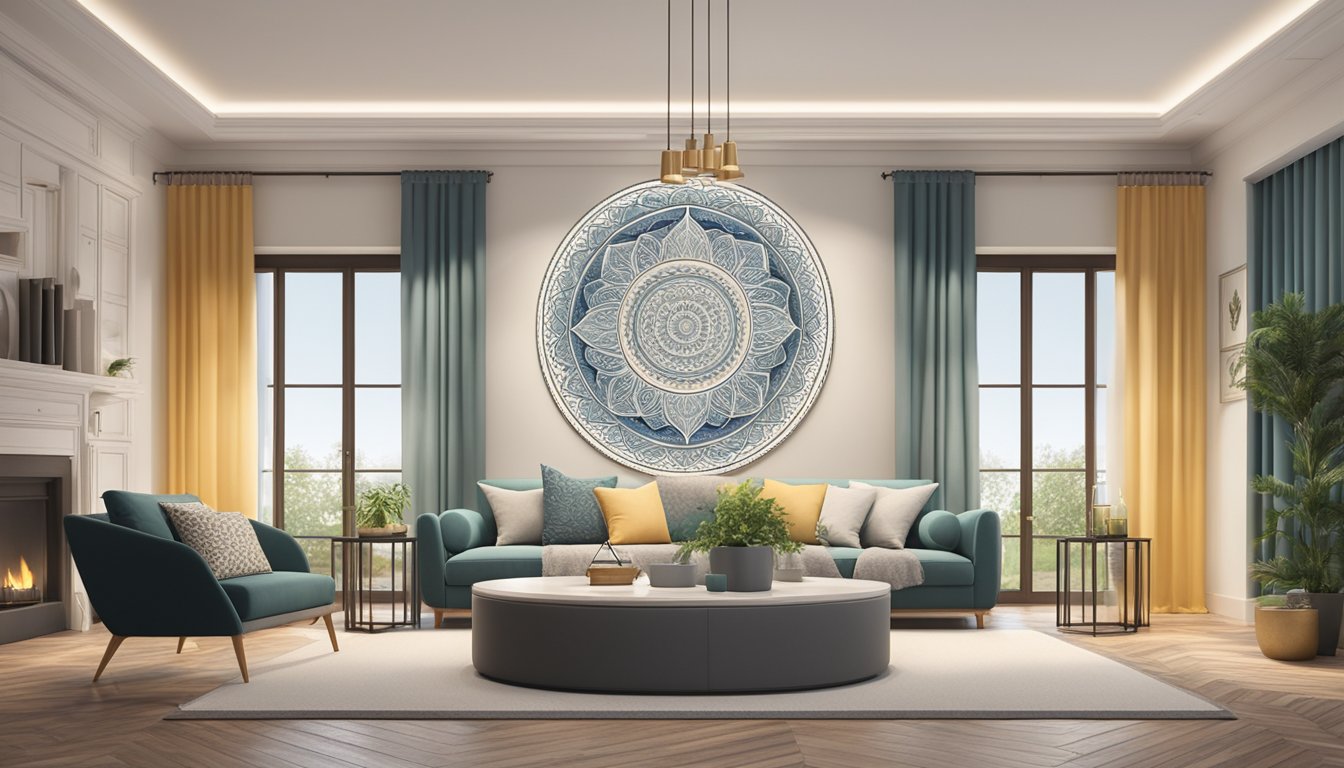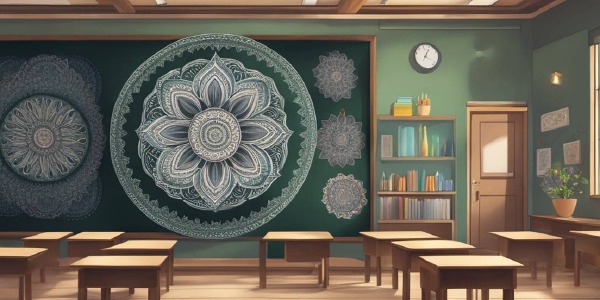The Mandala in Feng Shui: Embracing Harmonious Living
The Mandala, a complex, symmetrical, and ornate design, holds a significant place both in the spiritual realm and in Feng Shui, the ancient Chinese art of living in harmony with our environment. Within Feng Shui, the mandala is more than just an attractive decoration; it’s a potent symbol of balance and harmony. By uniting the spiritual symbolism of the mandala with the pragmatic principles of Feng Shui, individuals can enhance the flow of positive energy, or chi, within their living spaces.

Incorporating mandalas into a home’s design is not only about aesthetics but also about realizing the mandala’s potential to serve as a tool for meditation and healing. The strategic placement of a mandala in an environment can influence the energy flow and strengthen the sense of balance and peace within a space, reflecting the core tenets of Feng Shui. While each mandala’s design is unique, their intricate patterns often echo the balance sought in a well-arranged home.
Key Takeaways
- Mandalas symbolize balance and are integrated into Feng Shui to optimize energy flow.
- Strategic placement of mandalas can contribute to a peaceful and balanced home environment.
- Mandalas also serve as focal points for meditation, aiding in personal balance and healing.
Understanding Feng Shui and Mandalas

In the intricate practice of Feng Shui, the mandala holds immense significance as a symbol of balance and wholeness, seamlessly integrating with the flowing energy known as qi to create harmony within a space.
Origins and Meaning of Feng Shui
Feng Shui, an ancient Chinese art, is grounded in the understanding of the flow of energy, or qi, through the environment. It aims to balance this energy to bring harmony and prosperity to a person’s surroundings, whether in a home, office, or any other environment. The term itself translates to “wind” (Feng) and “water” (Shui), elements that circulate life’s energy through the cosmos.
The Mandala: A Symbol of Wholeness
A mandala, which means “circle” in Sanskrit, is a spiritual and ritual symbol representing the universe and wholeness. In Feng Shui, mandalas are used as spiritual teaching tools and sacred space to enhance concentration, establish a sacred environment, and facilitate enlightenment. They are complex designs, often exhibiting sacred geometry that resonates with the natural harmony of the cosmos.
Yin and Yang: The Concept of Dualism
The concept of Yin and Yang is central to Feng Shui, symbolizing the dual nature of the universe. The yin yang symbol depicts the balance of opposites – darkness and light, cold and warm, passive and active – and how they complement and depend on one another. This balance is crucial for maintaining the flow of qi and achieving harmony within a space.
The Five Elements and Their Significance
In Feng Shui, the universe is composed of five main elements:
- Wood: Growth and vitality
- Fire: Passion and energy
- Earth: Stability and balance
- Metal: Logic and intelligence
- Water: Wisdom and serenity
Each element interacts with the others in constructive and destructive cycles, and their balance is key to the favorable flow of energy.
Bagua: The Feng Shui Energy Map
The Bagua is an energy map used in Feng Shui to analyze and adjust the flow of qi in an environment. It is an octagonal grid containing eight trigrams that correspond to various life situations and are aligned with the cardinal directions. Using a Feng Shui compass, practitioners place the Bagua over the layout of a home or office to determine areas that need energetic adjustment.
The Role of Mandalas in Feng Shui

In Feng Shui, mandalas serve as powerful tools to establish balance and harmony within a space. They harness positive energy or qi to align various aspects of life, from health to wealth.
Balancing Energy with Mandalas
Mandalas are used in Feng Shui to even out the flow of qi in an environment. A balanced arrangement of shapes and colors in a mandala can neutralize negative energy, ensuring a peaceful and nurturing space. They often feature concentric circles or squares, symbolizing wholeness and stability.
Using Mandalas to Enhance Specific Life Areas
Each area of life, such as health, wealth, love, career, and relationships, corresponds to a specific section of the Feng Shui map, or Bagua. A mandala’s placement in a room can be strategically chosen to bolster the energy in one of these life areas. For example, a mandala with infinity symbols might be placed in the wealth corner to attract prosperity.
Shapes and Designs: Selecting the Right Mandala
The shape and design of a mandala are crucial in Feng Shui. A circle represents unity and protection, a square symbolizes stability and balance, and shapes like the infinity sign and double spiral invoke continuous growth and flow. The intricate designs within a mandala, often inspired by sacred geometry, can be selected to focus on specific intentions such as fostering creativity or supporting family and children.
Practical Applications of Mandalas in the Home

Mandalas serve as powerful symbols in Feng Shui, bringing balance and energy to any living space. When utilized correctly, they can enhance harmony and prosperity throughout the home.
Positioning Mandalas for Optimal Feng Shui
Living Room: Place mandalas in the east portion of the living room to promote health and family unity. In Feng Shui, east is the direction associated with wood energy, which supports growth and vitality.
Bedroom: For a calming ambiance conducive to rest and rejuvenation, position a mandala on the south wall of the bedroom. This direction correlates with the fire element in Feng Shui, encouraging warm energy and stable relationships.
Office: To attract success and clarity in decision-making, situate a mandala in the north area of the home office. North is linked to water elements in Feng Shui, fostering career advancement and financial flow.
Decorating with Mandalas: Room by Room
Living Room: Utilize artwork of mandalas with splashes of yellow for a welcoming atmosphere that stimulates social interactions and happy gatherings.
Bedroom: Opt for mandalas with soothing blue tones to promote relaxation and peaceful sleep.
Office: Incorporate mandalas with clear geometric designs and metallic colors like silver or gold to enhance concentration and career prosperity.
Colors and Materials: Feng Shui Considerations
Colors:
- Red: Represents fire and is used sparingly to stimulate passion and energy without overwhelming the space.
- Yellow: Symbolizes earth, bringing about stability and protection. It is suitable for rooms where family members gather.
- Brown: Associated with the earth element as well, promoting grounding and a sense of security.
Materials: Choose mandalas made from materials that correspond with the desired Feng Shui energy:
- Wood: for growth and vitality.
- Metal: to invite clarity and precision.
- Earth: to support balance and stability.
- Water: to enhance wisdom and fluidity of communication.
- Fire: to boost enthusiasm and leadership qualities.
Incorporating Mandalas into Meditation and Healing

Mandalas serve as powerful symbols in Feng Shui, often used to instill peace and promote healing. They embody stability, balance, and harmony, essential energies for both meditation and personal growth.
Mandalas as Tools for Meditation
Mandalas are visual aids that focus the mind during meditation. The intricate designs of mandalas offer a spiritual centering that echoes Zen practices. When meditators gaze upon a mandala, the complex patterns help to absorb distracting thoughts, fostering a state of peace and allowing for deeper concentration. Many individuals find the symmetry and balance within a mandala’s design to induce a meditative state, which can lead to enhanced personal growth and wisdom.
Feng Shui Mandala for Healing and Personal Growth
In the realm of Feng Shui, mandalas are more than mere decoration; they’re healing tools. Placing a Feng Shui mandala in a living space can create energy flows that nurture harmony and health. The colors and patterns within the design are chosen to align with specific Feng Shui principles, promoting a seamless flow of energy that contributes to vitality and well-being. When intention is placed into a Feng Shui mandala, it becomes an anchor for positive change and personal evolution.
Creating Your Own Mandalas for Personalized Feng Shui
Drawing or painting one’s own mandala is a practice rich in creativity and personal growth. This act of creation is not only an artistic endeavor but a personal rite that infuses the mandala with individualized intention and energy. To create a personalized Feng Shui mandala:
- Select colors that resonate with you and correspond to your desired energy outcome.
- Design patterns that reflect your personal journey and aspirations for growth.
- Place your mandala in an area of your home where its presence will align with your healing and personal development goals.
Each mandala that one creates is a reflection of their inner self, serving as a source of inspiration and a guide on their path to balance and harmony.
Enhancing Your Life with Feng Shui and Mandalas

Incorporating mandalas into Feng Shui practice is aimed at bringing balance and positive energy into various aspects of life. They serve as powerful tools in attracting love, prosperity, and protection.
Mandalas and Feng Shui for Relationships and Love
Mandalas are visual aids that embody the concept of harmony and can enhance the love and relationship sector of one’s living space. In Feng Shui, this sector is located in the far right corner from the main entrance, known as the love corner in the bagua. A mandala placed in this area should focus on the energies of love and harmony, ideally using a balance of the yin and yang to promote a stable relationship. Colors like pink or red can amplify romantic energy, while circular or paired patterns can symbolize unity and connection.
Attracting Prosperity and Success with Feng Shui Mandalas
Mandalas that are designed to attract wealth should utilize colors and symbols associated with prosperity and abundance. In Feng Shui, the wealth area is located in the southeast and is tied to the wood element. A green and gold mandala can be strategically placed here to boost the flow of positive energy towards financial success. Incorporating symbols of wealth, like coins or goldfish, within the mandala can further enhance its ability to attract abundance and fame.
Protection and Stability: The Power of Mandalas
For those seeking a sense of protection and stability, mandalas can act as barriers against negative energy and obstacles. Placed near the entrance or in the center of a home, which corresponds to the earth element in the bagua, these mandalas should promote feelings of security and safety. Using earthy colors like brown or terracotta and adding protective symbols can create a powerful shield in the physical and spiritual realms, fostering a stable environment where individuals can thrive.
Final Thoughts on Utilizing the Mandala in Feng Shui

Incorporating a mandala into one’s living space is a fusion of art and Feng Shui principles, aiming to create balance and harmony. This section recaps the practice and the path toward spiritual enrichment.
Reflecting on the Mandala’s Role in Balanced Living
Mandalas represent balance and harmony, both essential in Feng Shui. They are spiritual teaching tools that embody the journey to enlightenment. By integrating mandalas into a living space, individuals connect with a deeper sense of Zen and spirituality. The meticulous design of a mandala is believed to aid in meditative focus, enhancing wisdom and promoting balanced life energies.
- Enlightenment: Use of mandalas to foster self-discovery and clarity.
- Wisdom: Mandalas as mirrors reflecting inner truths, advancing knowledge in Feng Shui.
- Balance and Harmony: Accurate placement influences the flow of chi, elevating a room’s aura.
Continued Learning and Practice
Education in Feng Shui is an ongoing process, enriched by the cultural roots of Buddhism and spiritual practices. As spiritual teaching tools, mandalas facilitate continual learning and embody the core concepts of Feng Shui. They serve not only as objects of beauty but also as companions in the quest for a harmonious life.
- Feng Shui: Mastering energy flow to optimize living spaces.
- Education: Embracing the importance of lifelong learning in Feng Shui principles.
- Buddhism: Acknowledging the origins and influence of mandalas within Buddhist practices.
The incorporation of mandalas aligns with Feng Shui’s aim to balance one’s environment, which in turn, reflects upon their inner state. Through persistent study and application, one can leverage mandalas to achieve a more serene and mindful existence.
Conclusion

In Feng Shui, the mandala holds significant importance as a symbol that embodies the concept of balance and harmony. It is a visual representation that serves to remind one of the unity between the individual and the cosmos.
Incorporating mandalas in a space is believed to foster serenity and focus. They often feature in various forms, such as artwork or decor items. A mandala’s intricate designs and balance of elements reflect the Feng Shui principles of creating a peaceful and inviting environment.
- Practical Application: Individuals might place a mandala in their meditation area to aid concentration.
- Emotional Impact: The gentle symmetry can evoke feelings of calm and balance.
- Spiritual Significance: Mandalas can be a tool to guide one’s spiritual journey, providing a path to self-discovery and inner peace.
Utilizing the mandala is a gentle yet powerful way to align one’s living space with the energy that promotes well-being and tranquility. It connects the material to the spiritual, grounding its presence in the physical realm while offering a portal to the deeper aspects of existence.
Frequently Asked Questions

Mandalas serve as powerful tools in Feng Shui to create a sense of balance and harmony within a space. This FAQ section addresses how they can enhance energy flow, their ideal placement, and their symbology in Feng Shui practice.
How can a mandala enhance the energy flow in my living space according to Feng Shui principles?
In Feng Shui, a mandala is believed to radiate positive energy, encouraging a smooth flow of chi throughout a room. Its circular pattern represents the universe’s natural order, promoting tranquility and equilibrium.
What specific areas of my home are most suitable for placing a mandala to foster harmony?
The most suitable location for a mandala within a home is the meditation or living area. In Feng Shui, the center of the home, known as the Bagua map’s heart, is ideal for mandalas to balance energy and invite calmness.
In what ways does a mandala represent the principles of balance and symmetry in Feng Shui?
A mandala embodies Feng Shui’s balance and symmetry through its concentric structures. These arrangements mirror the concept of yin and yang, symbolizing unity and fostering a balanced environment.
Are there particular colors or designs in a mandala that are more auspicious for Feng Shui purposes?
Specific colors such as gold for prosperity, green for growth, and blue for calmness are particularly auspicious in Feng Shui mandalas. Designs that include flowing water, blooming flowers, or sacred symbols tend to attract positive chi.
How does one integrate mandalas with other elements in a room to maintain a balanced Feng Shui environment?
To integrate mandalas with other elements, one should consider the five Feng Shui elements: wood, fire, earth, metal, and water. For instance, a mandala with earthy tones can be placed with metallic items to foster grounding and clarity.
Can the positioning of a mandala within a space influence personal well-being, and if so, how?
Positioning a mandala in alignment with Feng Shui principles can significantly influence personal well-being. For example, hanging a mandala opposite the main entrance allows it to capture and distribute positive energy, promoting harmony and wellness for the occupants.



